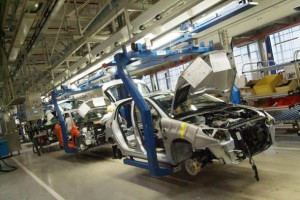Reuters Middle East
Yahoo News
By Aziz El Yaakoubi
Morocco expects auto industry exports to reach an annual 100 billion dirhams ($10.2 billion) by 2020 as a result of PSA Peugeot Citroen starting production at its new 557 million euro ($630 million) factory.
It will lift the overall industrial component of gross domestic product (GDP) to 20 percent, Morocco’s industry minister Moulay Hafid Elalamy told Reuters in an interview, adding that the plant will mean others may come to produce too.
Unlike many countries in the region, Morocco managed to avoid a big drop in foreign direct investments in the wake of the global financial crisis and the Arab Spring uprisings of 2011, partly by marketing itself as an export base for Europe, the Middle East and Africa.
It has attracted a number of big auto and aerospace investors in recent years, including Delphi, Bombardier and Eaton Corp..
Peugeot unveiled its plan last June to build the 200,000-vehicle capacity plant, following up rival Renault which has two factories making fully assembled cars in the kingdom.
Industry as a whole in Morocco accounts for only 16 percent of the country’s gross domestic product (GDP), but this will jump to 20 percent once Peugeot starts production.
“It will go even farther. We will exceed the 100 billion dirhams only in auto exports by 2020,” Elalamy said, speaking as part of the Reuters Middle East Investment Summit. “And it is not excluded that Morocco will attract other car and truck makers in the near future and could double these figures,” he said.
Elalamy said his department has been in talks with other foreign auto industry companies and an announcement would follow. Last week, a Moroccan delegation met with Italian carmakers in Turin.
Morocco’s auto industry has already surpassed traditional Moroccan exports such as agriculture and phosphates. At the end of September, total exports rose 6.2 percent from a year earlier to 160.07 billion dirhams, including 35 billion dirhams of auto exports against 34 billion for phosphate sales and 31 billion of agricultural products.
“With Peugeot, we will be at 600,000 vehicles produced annually. That is a critical size and our target is to reach 1 million vehicles annually in the coming years,” the minister said.
ENGINES AND ENGINEERING
The Peugeot plant is located near the coastal city of Kenitra and will begin assembling small and subcompact models for Africa and the Middle East in 2019. An initial annual production capacity of 90,000 vehicles is expected to rise to 200,000 as sales pick up.
It is a belated step for the Paris-based company to expand into lower-cost vehicles and emerging markets, reducing its exposure to Western Europe’s relatively stagnant demand and high production costs.
The plant, meanwhile, will source 60 percent of components locally, rising to 80 percent as the supply chain develops. It will have a 4,500-strong workforce once at the 200,000-vehicle capacity.
“We agreed also with Peugeot to make engines and not only assemble them in the Moroccan factory,” Elalamy said.
The minister added that Peugeot agreed on 1 billion euros of annual purchases of parts from local makers and the opening of an engineering centre with consulting firm Altran in Casablanca.
“That centre has already around 750 Moroccan engineers and qualified technicians, but the figure is expected to rise to 1,500 jobs.”
The Moroccan government sees the country’s GDP growing by 3 percent in 2016, slower than an estimated 5 percent in 2015 as agricultural output fell from an exceptional 2015. However, non-agricultural activity will increase by 3.1 percent in 2016, after 2.5 percent growth in 2015.
Follow Reuters Summits on Twitter @Reuters_Summits (Editing by Jeremy Gaunt)








